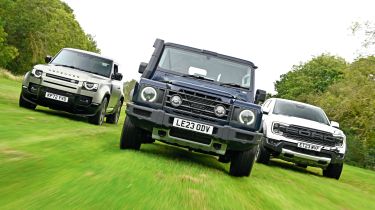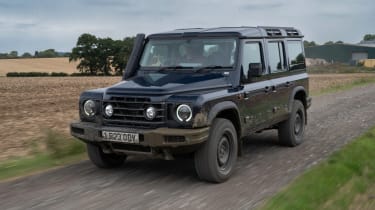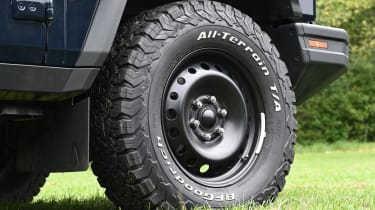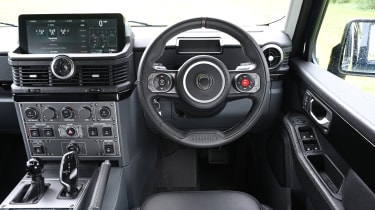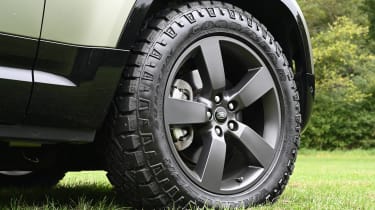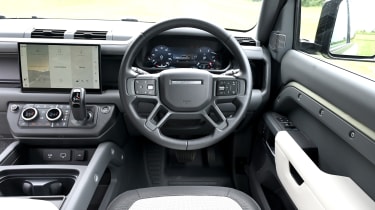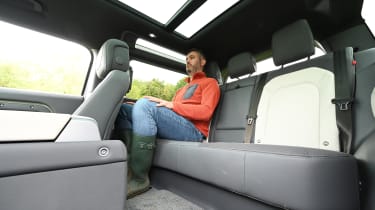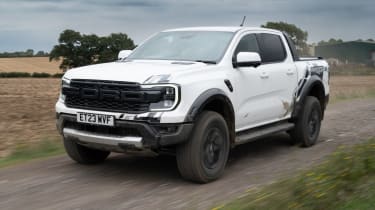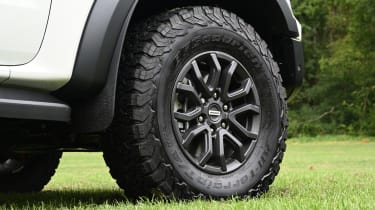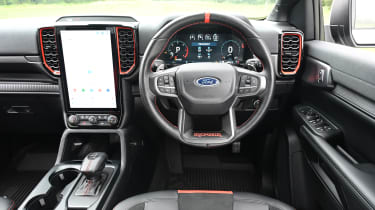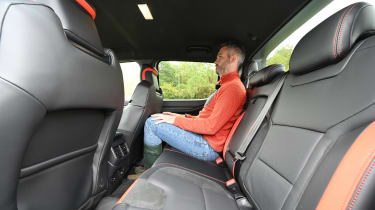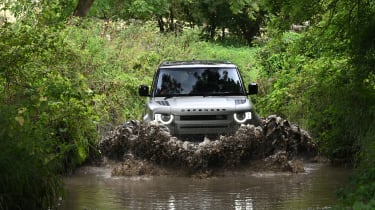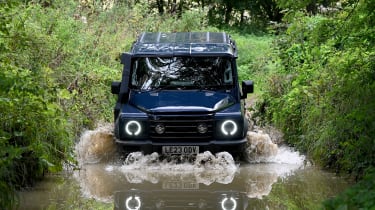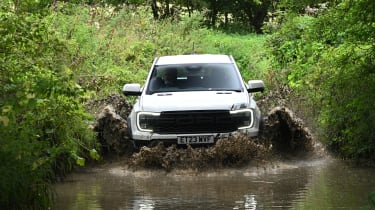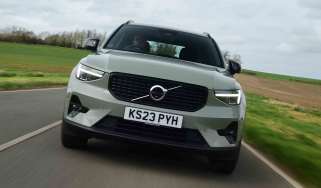Land Rover Defender vs Ineos Grenadier vs Ford Ranger Raptor: the ultimate off-road shootout
The Ineos Grenadier takes on the Land Rover Defender and Ford Ranger Raptor to see where it fits in the 4x4 sector
Starting a car company from scratch is no easy task, but when petrochemical boss Sir Jim Ratcliffe decided that the new Land Rover Defender wasn’t for him, that’s exactly what he did. The end product is the Ineos Grenadier, a chunky 4x4 that has plenty of traditional features and the promise of class-leading off-road ability.
To find out how the Grenadier stacks up, we’ve lined it up against the car it’s meant to be an alternative to. While Land Rover offers the Defender in a variety of body sizes and with a wide range of engines, we’re testing it in long-wheelbase guise, with a D250 diesel to match the Grenadier.
Our third contender is a left-field choice, but like the Ineos, the Ford Ranger Raptor will appeal to buyers who want something different. It’s more of a performance off-roader than a pick-up truck, courtesy of its twin-turbo V6 and bespoke suspension.
We’re taking all three off road to see how they perform, but the Real-World Road Test will also take their other talents into account.
Ineos Grenadier
| Model: | Ineos Grenadier Station Wagon Trialmaster |
| Price: | £76,000 |
| Powertrain: | 3.0-litre 6cyl in-line twin-turbo diesel, 249bhp |
| 0-62mph: | 8.8 seconds |
| Official Economy: | 23.1mpg/5.1mpl |
| CO2: | 286g/km |
| Annual VED: | £460 |
The Ineos Grenadier is being pitched as a tough, go-anywhere 4x4 that offers supreme off-road ability. It comes at a price, though, with the five-seat Station Wagon in Trialmaster trim starting at £76,000 before options.
Tech highlights
Producing a new car from scratch is no easy task, but while Ineos was criticised for not committing to building the Grenadier in the UK, its decision to use the former Smart factory in Hambach, France, has helped to fast-track its introduction.
Used - available now

2023 Ford
Puma
14,193 milesManualPetrol1.0L
Cash £14,500
2021 Kia
Sportage
16,979 milesAutomaticPetrol1.6L
Cash £20,000
2024 Volkswagen
Tiguan
32,892 milesManualDiesel2.0L
Cash £18,400
2025 Volkswagen
T-Roc
22,464 milesAutomaticPetrol1.5L
Cash £21,197The plant is overseen by vehicle production expert Magna, while a lot of the Grenadier’s tech has been bought in from established sources. As well as BMW’s six-cylinder petrol and diesel engines, Ineos also uses the company’s infotainment software – albeit with its own bespoke interface – while gearboxes and suspension dampers are sourced from ZF, the brakes are from Brembo, Eibach supplies the progressive-rate springs and BF Goodrich all-terrain tyres are used.
There’s body-on-frame construction for the best off-road ability possible, while the Grenadier is shorter and narrower than a Defender 110, but is taller and has more ground clearance. A ‘Utility Belt’ can be added to the car’s sides, using the same mounting system as the floor rails in the boot, while an optional rear ladder, side steps and roof-mounted safari windows can boost the rugged looks.
Transmission: The eight-speed automatic gearbox is connected to a two-speed transfer case for low-range gears, but while its rivals here have fully automated drive systems, the Grenadier has a secondary manual lever next to the drive selector. All Grenadiers have a centre-diff lock, while front and rear locks are part of the Rough Pack, which comes as standard with Trialmaster trim.
On and off the road
The Grenadier’s focus is off-road driving, but it’s far from being out of its depth on tarmac.
Around town: A lot has been made about the Grenadier’s recirculating-ball steering, but it’s easy to get along with once you’re tuned into it. The set-up isn’t as direct as a rack-and-pinion set-up, and there’s next to no self-centring, so you have to wind off as much lock as you’ve put on, but there’s plenty of power assistance to help you out.
A bigger issue is the Grenadier’s turning circle. A diameter of 13.5 metres is larger than that of the longer Ranger, so low-speed manoeuvres need some forward planning. Front and rear parking sensors and a reversing camera are fitted as standard, though, so you can position the car easily.
Other roads: The Grenadier’s steering doesn’t encourage spirited driving, but the car’s ride on tarmac is surprisingly good, considering its off-road focus. Big lumps and bumps can cause some shake, but in no way is it uncomfortable.
All-terrain tyres usually generate lots of road noise, but this is well suppressed in the Grenadier, even at motorway speeds, and wind noise is surprisingly low, considering the car’s boxy shape.
There’s lots of power from the BMW-sourced 3.0-litre diesel, while the eight-speed auto gearbox offers instant responses and smooth acceleration.
Off road: Where the Grenadier really shines is in the rough. The combination of triple diff locks, all-terrain tyres and excellent ground clearance mean it’s virtually unstoppable.
The hill-descent control system offers smooth progress even on very steep slopes; where the Grenadier’s rivals start to judder against their ABS systems, the Ineos keeps moving smoothly.
Ownership
The Grenadier’s chunky exterior looks are emulated by the dashboard. The numerous switches and buttons – including on the overhead console and multifunction steering wheel – give a military feeling to the cabin, while Trialmaster cars come with rubber flooring and fabric upholstery that’s easy to clean – drain holes in the floor mean it’s possible to hose the floor down if necessary.
The driving position is upright, and there’s a clear view out, but there’s no natural armrest on the driver’s door, so comfort over longer distances might become an issue. At least the Grenadier’s width means there’s plenty of space, and you’re not pinned to the door like in an old Land Rover.
The switchgear looks the part – although the BMW-sourced drive selector is a little out of place on the centre console – but it doesn’t feel very robust in places. The central click wheel works like BMW’s iDrive controller, but feels flimsy to use, while some of the switches don’t feel as solid as the Land Rover’s or Ford’s; when using the overhead controls, the panel flexes as you operate them.
There are no dials ahead of the driver; instead Ineos uses a Tesla-style layout, placing the speedo and other info on a section of the central screen.
Quality: While the Grenadier’s switchgear feels a bit flimsy in places, in other areas the car feels rock solid. The doors need a proper slam to get them shut – just like an old Land Rover – but feel suitably robust when you do, while the panel fit and paint finish are to a high standard.
If there are any further question marks about how reliable the Grenadier is going to be, Ineos addresses them by providing a five-year/unlimited- mileage warranty. That’s two years more than is offered by either Land Rover or Ford in the UK, while Ineos is accrediting a network of aftersales centres with the aim of having a workshop within 45 minutes of any destination.
Practicality
There’s a big step up into the cabin, while passenger and luggage space is acceptable more than outstanding.
Rear Space: Grab handles help with access, but side steps are an essential addition if you’re going to carry passengers on a regular basis, because the cabin floor is set high. Once in, there’s enough space for three, while there are Isofix child seat mounts on the outer chairs.
Boot: The back doors open in a 25:75 split so that the smaller side can open without fouling the spare tyre. That means you’ll need to open both doors to load anything but the smallest bag in the boot.
The load lip is high, but while folding the back seats creates more space than in the Defender, there’s a large step in the floor. A cargo cover is available as an option, too. Floor rails and lashing eyes allow you to strap items in the uncarpeted boot.
What to buy?
Which engine and trim we’d choose
- Engines: The Grenadier has a choice of two 3.0-litre engines: a 282bhp/450Nm petrol or a 246bhp/550Nm diesel. Prices are the same for both powerplants.
- Trim: The Utility Wagon is the commercial version of the Grenadier, and it can be upgraded to Trialmaster or Fieldmaster spec. These are standard on the Station Wagon and are priced identically.
- Options: Ineos offers Rough and Smooth packs that bundle features together. Leather seats and interior carpets can be added, as well as a host of off-road extras.
- Our choice: The diesel Trialmaster offers better economy and more off-road kit.
Land Rover Defender
One reason why the Grenadier exists is because of the direction that Land Rover took with the Defender, although as the sales figures prove, the change has been a hit with buyers. Here we’re testing the Defender in five-door 110 guise, although we have a short-wheelbase Defender 90 in our pictures. In D250 X-Dynamic HSE trim the Defender 110 undercuts the Grenadier by £6,500, but adding options can quickly bump up the price.
Tech highlights
Something that Land Rover and Ineos have in common is that both companies source engines from BMW. However, in this instance the Defender uses a JLR-developed 3.0-litre straight-six diesel. It matches the Grenadier’s 249bhp, but at 570Nm, is 20Nm ahead on torque.
Land Rover also turns to ZF for the Defender’s eight-speed automatic gearbox, and it comes equipped with a two-speed transfer case and centre and rear diff locks as standard – all of which are automatically engaged when you select the right mode in the Terrain Response system.
Where the two cars diverge is in terms of suspension. While the Ineos has traditional springs and dampers, the Defender 110 comes with air suspension (it’s optional for the short-wheelbase Defender 90 in our pictures), and that means there’s an adjustable ride height, depending on which terrain mode you have selected.
Safety: The Grenadier hasn’t been tested by Euro NCAP, but its rivals have, and both the Defender and Ranger earned five-star scores in 2022. The Land Rover was slightly ahead for adult occupant safety, but the Ford earned higher percentage scores in the other categories. All three have plenty of airbags and electronic safety systems, but Ineos doesn’t offer blind-spot detection on the Grenadier.
On and off the road
The Defender can’t quite match the Grenadier in the rough, but it makes up for it on tarmac.
Around town: At a fraction over two metres wide, the Defender’s biggest issue in urban areas is that you’ll have to think twice about guiding it down the narrowest streets or through width restrictions. The tall driving position will help, but the car’s squared-off arches mean the extremities are difficult to pinpoint without the use of Land Rover’s effective 360-degree camera system.
Other roads: Air suspension gives the Defender a greater breadth of ability than the Grenadier, with cushioned comfort at all speeds on tarmac. Only the biggest bumps are felt in the cabin, while opting for larger wheels doesn’t have a negative impact on the Defender’s ride quality. There is more road noise at higher speeds on big wheels, though.
At just under 2.4 tonnes, the Defender is weighty, but it’s still the lightest car here. However, it hides that mass well, both in corners and in a straight line, where there’s a 0-62mph time of 8.3 seconds.
Off Road: Land Rover’s Terrain Response system simplifies the task of selecting the right set-up for the car. Simply pick the surface that you’re driving on – there are Tarmac, Mud & Ruts, Gravel/Snow/Grass, Rock Crawling and Sand settings – and the Defender’s electronics will do the rest. An additional menu also allows you to configure the off-road settings the way you want them.
One benefit of air suspension is the ability to increase the Defender’s ride height for more extreme off-road conditions. There’s maximum ground clearance of 290mm on offer, which is 26mm more than the Grenadier can deliver, while a wading depth of 900mm is the best here.
One reason why the Grenadier exists is because of the direction that Land Rover took with the Defender, although as the sales figures prove, the change has been a hit with buyers. Here we’re testing the Defender in five-door 110 guise, although we have a short-wheelbase Defender 90 in our pictures. In D250 X-Dynamic HSE trim the Defender 110 undercuts the Grenadier by £6,500, but adding options can quickly bump up the price
Ownership
As with the Grenadier, the Defender features chunky styling cues throughout the cabin, but there are far fewer buttons because a large touchscreen handles most functions. The wide centre console divides the cabin in two (although buyers can add a middle jump seat as an option, making the Defender 110 a six-seater), while hard plastics and exposed screw heads are used as a design feature to amplify the car’s rugged character. Thankfully, build quality itself is closer to that of a Range Rover than the old Defender.
The stubby drive selector sits in a central panel, alongside two rotary controls that are surrounded by a set of buttons. These controls adjust the cabin temperature, while pressing them brings up the heated-seat settings. Two buttons between the dials unlock additional functions, with the left-hand wheel able to change fan speed, while
the right-hand one can be used to choose which Terrain Response mode you want, saving the need to go into the touchscreen menu.
The Defender’s SUV-biased nature benefits fuel economy, and an official figure of 33mpg is 10mpg ahead of the Grenadier’s, but only 3mpg ahead of the Ranger Raptor’s official figure, which highlights that large-capacity diesels are more about the power that they can offer, rather than out-and-out fuel economy. Using these cars off road won’t see you match these economy figures, because this kind of driving is done at low speeds with the engine running at idle most of the time.
Storage: The wide centre console has space for a smartphone-storage tray with charging connectors; there are side-by-side cup-holders behind that, plus an additional tray below. Further back, there’s a vast storage bin under the central armrest, while the glovebox is set low with a tray above it. The door bins aren’t the largest, but they offer more space than the Grenadier’s.
Practicality
The Defender is more car-like than the Grenadier, and has space for up to seven.
Rear Space: Select Access Height for the air suspension and the Defender lowers by 40mm to make it easier to get in and out. The Defender 90 is tight in the back, but the 110 has plenty of room and a good view out, although the dark materials can make it feel a little claustrophobic. An optional third row is available, which adds a sliding feature to the middle row to help create additional legroom in the back.
Boot: That side-hinged tailgate means you have to plan where you’re going to park so that you can open it easily, and it needs more space than the Grenadier’s back doors to open. The carpeted boot has 786 litres of space up to the parcel shelf, which rises to 1,875 litres when they’re folded. That’s not as much space as in the Grenadier, but there’s no step in the floor.
What to buy?
Which engine and trim we’d choose
- Engines: The Defender 110 comes with D250 and D300 diesels, P300, P400 and P525 petrols and as a P400e PHEV. But choose the Defender 90 and space limitations mean there’s no PHEV option.
- Trim: Land Rover offers a wide range of trims, with the D250 coming in SE, HSE and XS Edition specs, while X-Dynamic trim adds contrast exterior elements and different seat trim to SE and HSE models.
- Options: There are packs that can bump the price of the Defender up to exceed the Grenadier’s, some of which are needed to match its off-road ability.
- Our choice: The D250 has enough power and lower costs, while HSE trim has plenty of kit.
Ford Ranger Raptor
Given that the Ranger Raptor comes with a host of bespoke off-road kit and can’t carry a one-tonne payload, it sits separate from the rest of Ford’s pick-up truck range. At a touch over £60,000, it’s pricey, but undercuts both rivals here. The Raptor in our pictures is the diesel version.
Tech highlights
The Ranger Raptor was developed by Ford of Australia, and its spec sheet reads like it’s ready to tear across the Outback. Power comes from a 292bhp twin-turbo petrol V6 – so it’s 10bhp more powerful than the petrol Grenadier – while it’s 110mm wider than the standard Ranger, courtesy of widened wheelarches front and rear.
These cover a wider track and a bespoke suspension system featuring a multi-link rear set-up replacing the leaf springs found beneath the load bed of the standard Ranger. Fox Live Valve dampers are the clever part of the set-up, though, because the internals alter their response as you drive, offering firmer damping for sharp handling, or a softer setting for soaking up bumps.
As with the Defender, there are pre-set drive modes that automatically tailor the Raptor for different terrain, while a dedicated ‘R’ button on the steering wheel allows you to select your favourite set-up. Other electronic trickery includes launch control, an anti-lag system that keeps the turbos spinning when you’re off the throttle, and different exhaust settings, including one that in effect turns the system into an unsilenced set-up.
Pick-up rules: The Raptor’s multi-link rear suspension system is unable to cope with a one-tonne payload, so the Ford can’t be classed as a commercial vehicle. That means it doesn’t offer the tax benefits of other Ranger variants, and costs are emissions-based, so they’re very high.
On and off the road
The Ranger is the most comfortable pick-up currently on sale in the UK, and the rapid Raptor’s petrol punch and bespoke suspension system elevate Ford’s truck to another level.
Around town: A long, flat bonnet means the Ranger isn’t the easiest vehicle to position, although a standard-fit nose camera helps cover the truck’s blind spot directly ahead. As with the Defender, there’s a 360-degree camera system fitted, but the Ranger’s 5.4-metre length and 13-metre turning circle mean it’s not best suited to urban driving.
Other roads: The petrol Raptor’s unique dampers help it to deliver a smooth ride that’s firm but not crashy at most speeds. There’s lots of grip, too, so much so that the tyres are the main limiting factor when you’re pressing on. Switching from Normal to Sport mode firms up the steering slightly and ties the chassis down further.
The dampers limit pitch and roll at higher speeds, while the V6 petrol delivers good responses. The 10-speed auto gearbox shifts smoothly, but can’t be rushed, so acceleration is brisk rather than searing.
At higher speeds there’s more wind noise in the Ranger than you’ll find in its rivals, but the Raptor is still a comfortable cruiser.
Off road: As with the Land Rover, the Ranger has an off-road cruise control system that allows you to concentrate on your surroundings while the truck maintains a set speed of up to 18mph.
Select Baja mode, and the Raptor comes into its own at higher speeds. The ride is a little fidgety on rough tracks, but then, you can drive a lot faster and still be in complete control. The suspension absorbs bumps well, while tackling jumps sees the truck land smoothly without suspension crash.
Ownership
Ford has laid on plenty of tech with the new Ranger, and because it’s the top-spec model, the Raptor is loaded with all of it. As with the Defender, there’s a large touchscreen that houses the majority of the controls, but the 12-inch display has a portrait layout that ties in well with the design of the interior.
One concession to convenience is the set of climate controls located at the bottom of the screen, which are quick and easy to use when on the move, but there are additional functions on the touchscreen that are easier to use when parked. Beneath the display is a storage shelf, which features a grippy wireless phone-charging pad, plus two sockets, one standard USB and one USB-C.
There’s a rotary controller behind the gearlever that selects each drive mode, while other functions are accessed via the multifunction steering wheel and 12-inch driver’s display. The leather-trimmed wheel feels good to hold, with chunky metal gearshift paddles behind, while the leather and Alcantara seat trim adds to the sporty feel inside.
There’s decent storage, with twin cup-holders next to the gearlever, plus a deep storage area under the central armrest. The door bins are decent, there are pop-out cup holders at either end of the dashboard, while the glovebox is complemented by another covered storage area just above.
As with the Grenadier, Ford has fitted a bank of pre-wired switches in the overhead console, so that any additional accessories, such as spotlights, can be hooked up without having to make holes in the dashboard for extra switches.
Dealers: Sales of the Ranger are handled by Ford Pro, so the company’s 28th-place finish in the most recent Driver Power manufacturer poll isn’t necessarily representative here. Land Rover came 14th in the same survey, ahead of similar premium brands such as BMW, Audi and Mercedes.
Practicality
The Raptor’s unconventional nature extends to its cargo-carrying ability.
Rear Space: The back seats of the Raptor offer the same amount of space that you’ll find in a standard Ranger. There’s leather trim and a decent amount of room, although the vertical rear of the cab means the seats are more upright than they are in the two 4x4s here.
As with the Grenadier, there are Isofix attachments in the back, but the Defender also has a set on the front passenger seat.
Boot: The cargo bed offers a vast load area, although a tonneau cover is a necessary addition if you want secure storage. Access is limited due to the large tailgate and high sides of the bed.
The Raptor has a maximum towing weight of 2.5 tonnes, but that’s 1,000kg less than either of its rivals can haul,
and less than the standard Ranger, too.
What to buy?
Which engine and trim we’d choose
- Engines: As well as this V6 petrol, the Ranger Raptor is also available with a 207bhp 2.0-litre diesel for £3,000 less. It features the previous-generation Raptor’s Fox dampers and does without the petrol truck’s launch control, anti-lag system, front diff lock, drive modes and chrome exhaust tips.
- Trim: The Raptor is a standalone flagship model in the Ranger line-up.
- Options: There’s a decal pack (£600), as seen on our test truck, while the Raptor Pack (£2,100) adds a plastic roll bar and powered tonneau cover to the cargo bed.
- Our choice: We’d choose the petrol-powered version for the full Raptor experience.
Results
Winner: Land Rover Defender
| Pros | Cons |
| Great on and off road | Not as focused as Ineos |
| Comfortable at all speeds | Options can ramp up price |
Land Rover purists were up in arms when the current Defender appeared, but there’s no doubt that its reinvention for the 21st century gave it a new lease of life.
It delivers the upmarket qualities of the Range Rover models, while adding a rugged touch that extends its appeal to a broader spectrum of buyers. A wider range of abilities, a higher-quality interior and lower overall costs mean it has the edge over its rivals here.
Runner-up: Ineos Grenadier
| Pros | Cons |
| Unstoppable off road | Unwieldy around town |
| Surprisingly capable on the road | Some flimsy switchgear |
If you need a car solely for off-road driving, then the Grenadier is second to none. What’s more, it manages to combine this with on-road ability that is perfectly acceptable in most situations – urban driving excluded.
The Grenadier feels tough and has real charm, and Ineos should be applauded for producing a car from scratch that comes close to toppling one of the best in the business.
Third place: Ford Ranger Raptor
| Pros | Cons |
| Lots of fun on and off road | Bulky to manoeuvre |
| Good value in this company |
Looks won’t be to all tastes |
We included the Ranger Raptor here because, like the Grenadier, it’s a bit of a niche 4x4 with no direct competitors. It’s probably a bit too ‘in your face’ for potential Ineos or Land Rover buyers, but what it lacks in subtlety it makes up for with a unique driving experience.
It’s huge fun to drive in the right environment, as well as offering practicality and comfort that make it a plausible performance SUV rival.
Specs and prices
| Ineos Grenadier Station Wagon Trialmaster | Land Rover Defender 110 X-Dynamic HSE | Ford Ranger Raptor 3.0 V6 EcoBoost | |
| On the road price/total as tested | £76,000/£78,730 | £70,785/£70,785 | £60,064/£60,064 |
| Residual value (after 3yrs/36,000) | £38,456 (50.6%) | £49,550 (70.7%) | £25,948/43.2% |
| Depreciation | £37,544 | £20,535 | £34,116 |
| Annual tax liability std/higher rate | £5,427.16/£10,854.30 | £5,019.79/£10,039.60 | £4,247.89/£8,495.80 |
| Annual fuel cost (10k/20k miles) | £3,802 (£6,337) | £2,661 (£4,436) | £4,204 (£7,007) |
| Service costs (3 years) | TBC | £565 (2 services) | £590 (3 years) |
| Length/wheelbase | 4,895/2,922mm | 5,018/3,022mm | 5,363/3,220mm |
| Height/width | 2,050/1,930mm | 1,972/2,008mm | 1,873/2,208mm |
| Engine | 6cyl in-line turbodiesel/2,993cc | 6cyl in-line turbodiesel/2,996cc | V6 twin-turbo petrol/2,956cc |
| Peak power | 249bhp/3,250rpm | 249bhp/4,000rpm | 292bhp/5,500rpm |
| Peak torque | 550Nm/1,250rpm | 570Nm/1,250rpm | 491Nm/2,300rpm |
| Transmission | 8spd auto/4WD | 8spd auto/4WD | 10spd auto/4WD |
| Fuel tank/AdBlue tank capacity | 90 litres/17 litres | 89 litres/21 litres | 80 litres/N/A |
| Boot capacity (seats up/down) | 1,152/2,035 litres | 786/1,875 litres | 1,233 litres |
| Kerbweight/payload/towing weight | 2,816/684/3,500kg | 2,361/839/3,500kg | 2,454/652/2,500kg |
| Turning circle | 13.5 metres/yes | 12.8 metres/yes | 13.0 metres |
| Basic warranty/recovery | 5yrs (unlimited)/2yrs | 3yrs (unlimited)/3yrs | 3yrs (60,000)/1yr |
| Driver Power manufacturer position | N/A | 14th | 28th |
| Euro NCAP: Adult/child/ped./assist/stars | N/A | 85/85/71/79/5 (2022) | 84/90/74/84/5 (2022) |
| 0-62mph/top speed | 8.8 seconds/99mph | 8.3 seconds/117mph | 7.9 seconds/112mph |
| Test economy/range | 23.1/457 | 33/646 | 20.5/361 |
| WLTP combined | 23.1 mpg | 33mpg | 20.5mpg |
| Actual/Claimed CO2/tax bracket | 286g/km/37% | 224g/km/37% | 315g/km/37% |
| Number of airbags/Isofix points | Six/two | Six/three | Seven/two |
| Parking sensors/camera | Front & rear/yes | Front & rear/360 degrees | Front & rear/360 degrees |
| Lane departure/blindspot/AEB | Yes/no/yes | Yes/yes/yes | Yes/yes/yes |
| Climate control/cruise control | Yes/yes | Two-zone/adaptive | Two-zone/adaptive |
| Leather/heated seats/wheel | £1,835/£340/no | Yes/climate/yes | Yes/yes/yes |
| Metallic paint/LED lights/all-terrain tyres | £970/yes/yes | £895/yes/£255 | £720/yes/yes |
| Keyless entry & go/side steps/tow bar | No/£845/£630 | Yes/£1,305/£780 | Yes/yes/£454 |
| Sat-nav/digital dashboard/USBs | No/no/two | Yes/yes/four | Yes/yes/four |
| Online services/wireless charging | No/no | Yes/no | Yes/yes |
| Apple CarPlay/Android Auto | Yes/yes | Yes/yes | Wireless/wireless |

